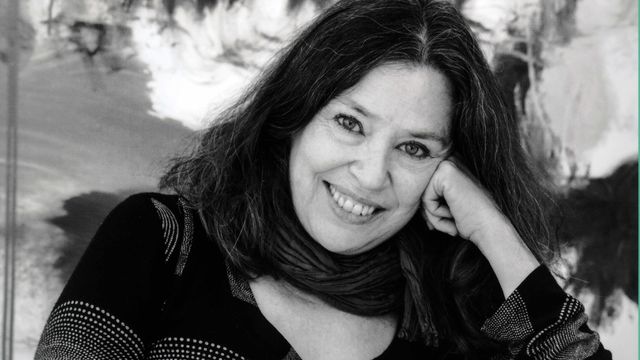
Magali Lara
Born in Mexico City in 1956, Magali Lara works in a variety of mediums, including painting, collage, artist's books, and installation. Her delicate abstract drawings and brushstrokes recall natural forms like flowers and rhizomes, and her pieces foreground the tension between the monumental and the precarious. The artist studied at the Universidad de Guadalajara (BA 2008) and Universidad Autónoma del Estado de Morelos (MFA 2011). Initially intending to be a writer, Lara has continued to use text in her visual production, often juxtaposed with drawings and photographs. Early in her career in the 1970s, she produced collages with photocopies and drawings, such as Ventanas (Windows, 1977–78), exploring biographical themes. The series of drawings Tijeras (Scissors) revolved around the theme of violence and was presented in her first solo exhibition, at the Escuela Nacional de Artes Plásticas (Mexico City, 1976).
Still in the 1970s Lara participated in Grupo Março, one of numerous art collectives that emerged in Mexico after the 1968 student movement. The sexist bias of such grupos, which downplayed questions especially important to women (for instance, the body and sexuality), led Lara and other artists to start women-oriented discussion groups, projects, and exhibitions. In the 1980s she collaborated with the influential feminist artists Mónica Mayer (b. 1954), Maris Bustamante (b. 1949), and Rowena Morales (b. 1948). One example of their collaboration is the environmental installation Mi casa es mi cuerpo (My house is my body), developed with Mayer and Morales and presented at the Museo de Arte Carrillo Gill in the 1983 exhibition Cartas a una monja portuguesa.
During the 2000s Lara turned her attention to projects involving music and theater. In 2009 she presented Glaciares with the composer Ana Lara, her sister, at the Sala de Arte Público Siqueiros in Mexico City. Two years later she collaborated with the Mexican composer Javier Torres Maldonado on the play Un posible día (A possible day) at the Centre National de Création Musicale in Paris. She was a resident artist at the Amate-Boréal Art/Nature Boca del Cielo in Chiapas, Mexico, in 2002, and at the Banff Centre for the Arts in Alberta, Canada, in 2000. Lara received an honorific mention at the 5th Bienal Iberoamericana de Arte (Mexico City, 1986) and the Artist Book Award for Que hurte en ti lo que me pertenece (Let him steal from you what belongs to me) at the Feria Internacional de Libro de Artista (Guadalajara, 2013). Her work is in the collections of the Museum of Modern Art, New York; Museum of Latin American Art, Long Beach, CA; and Museo de Arte Contemporáneo de Oaxaca. The artist lives in Cuernavaca, where she teaches at the Universidad Autónoma del Estado de Morelos.
—Mariana von Hartenthal
Selected Solo Exhibitions
1989 Magali Lara: Del cielo, Instituto Cultural de México, Paris
1998 Magali Lara: Serpiente, Museo de Arte Carrillo Gil, Mexico City
2004 Magali Lara: Los ojos no, Centro Cultural Recoleta, Buenos Aires
2010 Magali Lara: Glaciares, Visual Arts Center, Austin
2015 Magali Lara: Intemperie, Museo Nacional de la Estampa, Mexico City
Selected Bibliography
Baranda, María, and Magali Lara. Causas y azares / Causes and randomness. Translated by Roberto Tejada. Mexico City: Aldus, 2000.
Giunta, Andrea. "Feminist Disruptions in Mexican Art, 1975–1987." Artelogie, no. 5 (October 2013). http://cral.in2p3.fr/artelogie/spip.php?article271.
Lara, Magali. "La memoria es como una piedra pulida." In Crítica feminista en la teoría e historia del arte, compiled by Karen Cordero Reiman and Inda Sáenz, 415–20. Mexico City: Universidad Iberoamericana, 2007.
———. Mi versión de los hechos. Mexico City: Universidad Nacional Autónoma de México, Dirección General de Artes Visuales, 2004.
Nevin, Paul, and Néstor García Canclini. Magali Lara. Mexico City: Impronta, 2006.


